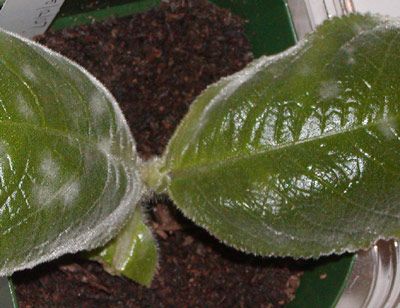Mildew
Don Mahoney, of the San Francisco Botanic Garden (formerly Strybing
Arboretum), noted that the Garden complies with organic standards and
thus cannot use remedies that don't qualify as organic.
His anti-mildew recipe is as follows:
- One gallon water.
- One tablespoon vegetable oil.
- One tablespoon dish detergent.
- One teaspoon sodium bicarbonate (baking soda).
Since there are 16 tablespoons in a cup and 16 cups in a gallon,
that makes 256 tablespoons in a gallon, so the proportions are
(for those who don't use cups, pints, and quarts every day):
- 768 (say, 700-800) parts water.
- Three parts vegetable oil.
- Three parts dish detergent.
- One part sodium bicarbonate (baking soda).
Presumably the oil and soap are to make the mixture stick, and the
sodium bicarbonate has some effect (such as changing the pH) to make
the leaf surface inhospitable to mildew organisms.
Ingrid Lindskog mentioned that she published a similar recipe in
Gesneriastnytt.
Mike Kartuz recommended potassium bicarbonate, but I have not been
able to find a convenient source for that.
Apparently, this is a remedy which has been known for at least a
couple of decades, but now I have my own experience with it.
I can report that this stuff works!
First, it doesn't damage the leaves.
Of course, the mildew itself has damaged the leaf where it
is growing, but the spray does not itself harm the leaves of the
plants to which I have applied it.
Probably, one can apply too much, but so far the amounts I have
applied have not caused any problems.
Second, it actually gets rid of mildew.
Usually one spraying has been enough, but in a couple of cases,
I had to spray other leaves on the same plant.
I have used it on (among other plants) Sinningia richii,
Sinningia barbata "Tancredo Neves", and
Corytoplectus capitatus.
Instructions
Just mix up the recipe above, pour it into a spray bottle,
take the plant to an appropriate area, and spray until the
affected leaves are completely wet.
Try not to let the spray drip onto the soil.
After a few sprayings, the buildup of sodium in the soil might be
harmful to the plant.
This may be the reason for recommending potassium carbonate, as mentioned
above, since potassium is a nutrient rather than a harmful salt.
For that reason, it is helpful to spray in a location (such as a sink)
where the plant can be tilted so that the runoff from the leaves
drips somewhere it won't make a mess.
Prevention
It has become quite clear that mildew spores are always with us.
They are in the air, on our clothing, on our light stands, on our plants, and
probably in our noses.
Thus any strategy based on quarantines, isolation, fire lanes, and sterilization
is doomed to fail.
Instead we need to start from the assumption that mildew spores will reach our plants.
They will germinate and attack every one of our plants.
We already know that most of our plants resist this attack.
Our task is to raise this resistance rate to 100%.
Sinningia richii has proved a good test case for mildew prevention.
A number of skilled growers have been tackling the "Robson Lopes" form of this species,
prized for its yellow flowers.
Most of these growers have experienced the susceptibility of this species to mildew
(the phrase "mildew magnet" has been used frequently).
One thing which has been noticed is that plants grown in high humidity are not
more likely to get mildew.
This might be contrary to what one would expect, if mildew were thought of as a
result of dampness.
Instead, it appears likely that S. richii plants grown in
an enclosed environment thrive better and are more vigorous.
Thus, my tentative hypothesis is...
Vigorous, healthy plants resist mildew better, regardless of environment.
It doesn't seem plausible that S. richii is heavily attacked
by mildew in its native habitat.
If it were, it would have evolved resistance or been exterminated.
Therefore the challenge is to find the right conditions to grow plants which will
be healthy enough to resist fungal attack.
I know you're tired of hearing me say this, but...
Experimentation is the key. Try things and learn.
Countermeasures are good in the short run.
But in the long run, we need to figure out how to thwart mildew before it can get going.
